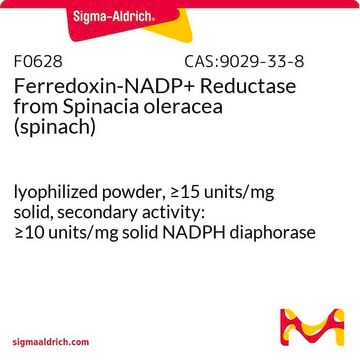F3629
Ammoniumeisen(III)-sulfat Dodecahydrat
ReagentPlus®, ≥99%
Synonym(e):
Ammoniumeisenalaun, Eisen(III)-ammoniumsulfat, Eisenammoniumalaun
About This Item
Empfohlene Produkte
Qualitätsniveau
Produktlinie
ReagentPlus®
Assay
≥99%
Eignung der Reaktion
core: iron
reagent type: catalyst
mp (Schmelzpunkt)
39-41 °C (lit.)
Lagertemp.
2-8°C
SMILES String
N.O.O.O.O.O.O.O.O.O.O.O.O.[Fe+3].OS([O-])(=O)=O.[O-]S([O-])(=O)=O
InChI
1S/Fe.H3N.2H2O4S.12H2O/c;;2*1-5(2,3)4;;;;;;;;;;;;/h;1H3;2*(H2,1,2,3,4);12*1H2/q+3;;;;;;;;;;;;;;;/p-3
InChIKey
LCPUDZUWZDSKMX-UHFFFAOYSA-K
Suchen Sie nach ähnlichen Produkten? Aufrufen Leitfaden zum Produktvergleich
Anwendung
- A catalyst to synthesize 1,4-dihydropyridines via one-pot three-component condensation reaction of dimedone, aldehydes, and 3-aminocrotonate in ethanol.
- An additive in the reduction of aromatic nitro compounds to the corresponding amino compounds in the presence of alumina-supported hydrazine hydrate as a catalyst.
Rechtliche Hinweise
Signalwort
Danger
H-Sätze
P-Sätze
Gefahreneinstufungen
Eye Dam. 1
Lagerklassenschlüssel
13 - Non Combustible Solids
WGK
WGK 1
Flammpunkt (°F)
Not applicable
Flammpunkt (°C)
Not applicable
Persönliche Schutzausrüstung
dust mask type N95 (US), Eyeshields, Gloves
Hier finden Sie alle aktuellen Versionen:
Besitzen Sie dieses Produkt bereits?
In der Dokumentenbibliothek finden Sie die Dokumentation zu den Produkten, die Sie kürzlich erworben haben.
Kunden haben sich ebenfalls angesehen
Unser Team von Wissenschaftlern verfügt über Erfahrung in allen Forschungsbereichen einschließlich Life Science, Materialwissenschaften, chemischer Synthese, Chromatographie, Analytik und vielen mehr..
Setzen Sie sich mit dem technischen Dienst in Verbindung.










